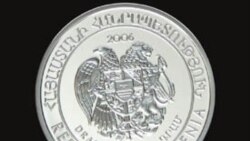By Emil Danielyan
Armenia’s national currency, the dram, regained some of its lost value as the situation in the local currency market continued to stabilize on Thursday.The dram rallied by 2.2 percent from 372 to 363 per U.S. dollar in daily trading at the NASDAQ OMX Armenia stock exchange. The total value of currency transactions there was reported at $7.27 million. There were also no signs of dollar shortages in currency exchange shops across Yerevan.
The Central Bank of Armenia (CBA) declined to specify the amount of dollars it sold to commercial banks on Thursday. The CBA’s decision on Tuesday to sharply cut back on its heavy dollar injections sent the dram’s value plummeting by 20 percent.
The dram’s devaluation was welcomed by the World Bank and the International Monetary Fund (IMF), with the latter pledging to disburse $540 million in emergency loans to Armenia. The IMF believes that the Armenian currency has grown overvalued by 20-30 percent since the onset of the global financial crisis. It has pointed, in particular, to a significant fall in Armenia’s export revenues and multimillion-dollar remittances from Armenians working abroad.
Western analysts also praised the decision to float the dram. “It gives them the flexibility to adjust to new economic scenarios,” Michael Ganske, head of emerging-markets research in London at Commerzbank, told Bloomberg news agency. “In the current global environment it’s very, very hard to maintain an overvalued currency.”
“Armenia’s decision to seek a precautionary IMF program and allow a freer float for the currency is a welcome signal of the authorities’ cautious approach to managing current difficulties,” Andrew Colquhoun, a director at the Fitch credit rating firm, said in a statement. “However, the reserves loss to end-January indicates the scale of the shock, and suggests there is little room for policy missteps which could undermine macroeconomic stability and increase downwards pressure on the ratings.”
Citing the rescue package promised by the IMF, Fitch on Thursday gave Armenia a “currency issuer default rating” of BB that indicates “stable outlooks” for the country’s monetary system.
The CBA has spent at least $360 million of its hard currency reserves on keeping the dram’s exchange virtually unchanged until the beginning of this week. This policy has been strongly criticized by economists critical of the Armenian government. They believe that the authorities should have ensured instead a gradual depreciation of the dram in recent months.
But Tigran Sarkisian, the prime minister and former CBA governor, said in televised remarks late Wednesday that this would have only caused more uncertainty and speculative currency trading. Sarkisian insisted that the authorities have sufficient resources to prevent further sharp exchange rate fluctuations. In addition, he said, private Armenian banks hold a total of $700 million in cash that can also be used for maintaining financial stability.
Sarkisian also claimed that the prices of imported foodstuffs and fuel, pushed up by the dram depreciation, will fall back in the next few days. Some products such as vegetable oil and sugar now cost 20 percent more than they did before the currency crisis.
(Photolur photo)




